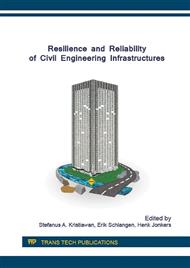p.148
p.154
p.158
p.166
p.175
p.181
p.188
p.193
p.202
Experimental Investigation on the Flexural Performance of Brick Masonry Wall Retrofitted Using PP-Band Meshes under Cyclic Loading
Abstract:
Numbers of residential houses were damaged in some areas caused by earthquakes. The damages greatly affected the number of losses. Most of the houses in some countries are made of brick unreinforced masonry (URM) walls. Improving the structural performance of this kind of masonry has become important. For this reason, experimental study was conducted on the flexural performance of brick walls retrofitted with strapping band (polypropylene/pp-band). The walls were constructed using bricks produced manually with joint mortar ratio of 1 PC: 6 sand, that chosen to represent the actual field conditions of the communities in Indonesia. The aims of the study were to determine the out of plane flexural performance of the non-retrofitted and retrofitted brick masonry walls under cyclic loading by using some variations of the distance between pp-band. The walls were loaded to produce flexural bending that caused vertical and horizontal cracks. The results of the test showed that the retrofitted walls failed by large deformation. After crack, the strength reduced to about 25-50% of the crack load and then regained progressively as residual strength until 150% higher than the strength at crack load by large deformation due to the strapping band mesh. The wall with 10 cm pp-band distance should be used as optimum solution for retrofitting
Info:
Periodical:
Pages:
175-180
Citation:
Online since:
July 2016
Price:
Сopyright:
© 2016 Trans Tech Publications Ltd. All Rights Reserved
Share:
Citation:


